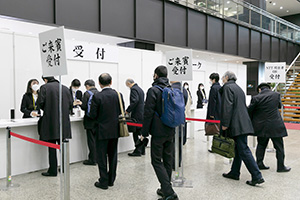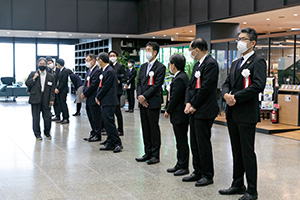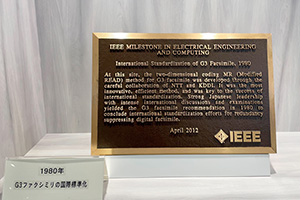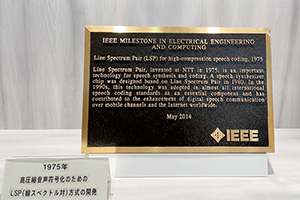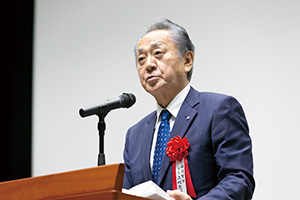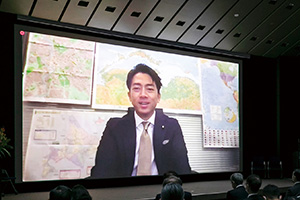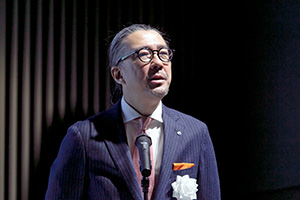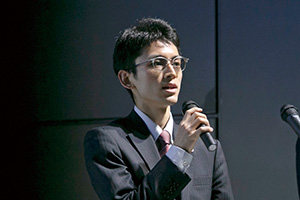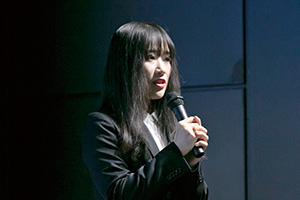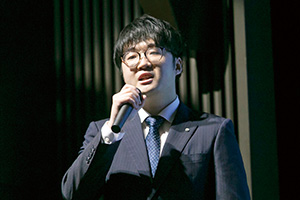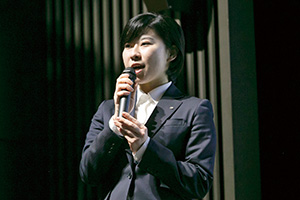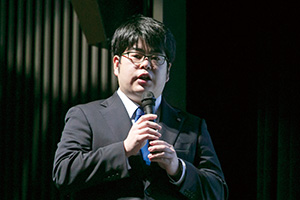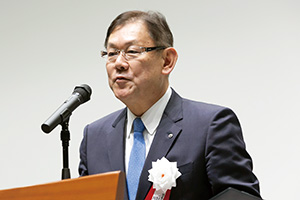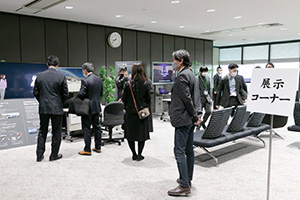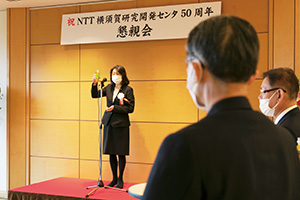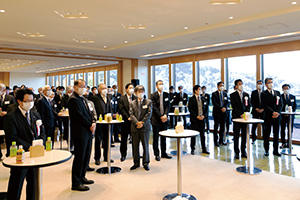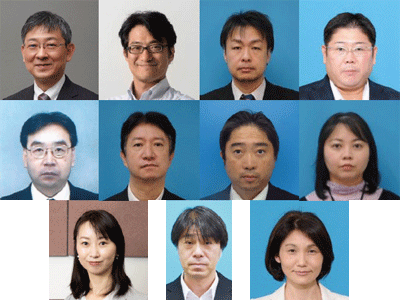 |
|
|
|
|
|
Special Report Vol. 21, No. 5, pp. 50–55, May 2023. https://doi.org/10.53829/ntr202305sc1 50th Anniversary of NTT Yokosuka R&D CenterAbstractNTT Yokosuka R&D Center was established in November 1972 as the third research laboratory of the Nippon Telegraph and Telephone Public Corporation (the predecessor of NTT), and it celebrated its 50th anniversary in 2022. To commemorate this anniversary, the Center held a commemorative event on December 9, 2022. At the event, Mr. Shinjiro Koizumi, a member of the Japanese House of Representatives, and Mr. Katsuaki Kamiji, mayor of Yokosuka City, gave their greetings, and many executives from Yokosuka-based companies and organizations attended the event, which reaffirmed the bond between the Center and the community. Keywords: regional cooperation, NTT, Yokosuka 1. IntroductionBlessed with good weather, the NTT Yokosuka R&D Center 50th Anniversary Lecture was held on December 9, 2022. The event was attended by approximately 100 guests, mainly companies and organizations based in the Yokosuka Research Park (YRP), the nearby neighborhoods of Yokosuka City, as well as alumni of NTT Yokosuka R&D Center. It provided an opportunity to introduce the past and present achievements of the Center and reaffirm our commitment to deepening regional ties and contributing to social development through regional cooperation (Photos 1, 2).
2. Commemorative speechesIn the first commemorative speech, Tomoyoshi Oono, senior vice president, head of NTT Service Innovation Laboratory Group, introduced Yokosuka R&D Center at the beginning of his lecture and showed a commemorative video (Photo 3).
NTT Yokosuka R&D Center was opened in November 1972 by then President Shigeru Yonezawa of the Nippon Telegraph and Telephone Public Corporation with the declaration that it would “conduct research under five themes: information-processing systems for data communications, large-capacity-transmission systems, ocean-communications systems, development and application of satellite communications, and research and practical application of mobile communications.” These themes spread throughout the world in the form of the popularization of the Japanese-made general-purpose mainframe-computer series “DIPS (Dendenkosha Information Processing System),” the construction of optical backbone communications networks, the launch of Japan’s first domestically produced communications satellite, and the development of mobile communications that started from car phones and led to smartphones. Another technology that has flourished at Yokosuka R&D Center is image-encoding technology. Image-coding technology began with the research and development of facsimile (fax) machines and culminated in the establishment of the G3FAX international standard in 1980, which was awarded an IEEE Milestone in 2012 (Photo 4).
In 2014, our high-compression speech-coding technology, called Line Spectrum Pair (LSP) and developed in 1975, was recognized with an IEEE Milestone (Photo 5). This award resulted from the adoption of LSP as the voice-coding standard of the U.S. federal government in 1991 as well as its inclusion in the 3rd Generation Partnership Project (3GPP) and 3GPP2 standards for third-generation cell phones in 1999. As of December 2022, 41 Japanese companies have been awarded IEEE Milestones in recognition of technologies and achievements—such as the Tokaido Shinkansen bullet train, automatic ticket gates for train stations, solar cells, VHS (Video Home System) video, and car-navigation systems for automobiles—that have provided the foundation for modernization.
In the 1990s, NTT’s image-and-video coding technology was standardized. For example, in 1990, when NTT held the chair of the ITU-T (International Telecommunication Union - Telecommunication Standardization Sector) working group (WG), H.261 was internationally standardized for video coding. Around that time, when NTT was leading international standardization as the chair of the International Organization for Standardization/International Electrotechnical Commission (ISO/IEC) Joint Technical Committee 1/Subcommittee 29, MPEG (Moving Picture Experts Group)-2, which is the basis of digital broadcasting, received the US Emmy Award for Technology Development (Photo 6). In 1994, when NTT held the chair of the ISO WG, the JPEG (Joint Photographic Experts Group) still-image-coding system was also standardized.
Next to speak, Mr. Kamiji expressed his expectations for an approach to solving problems through the fusion of cyberspace and physical space taking the post COVID-19 pandemic era into consideration (Photo 7). After that speech, focusing on Yokosuka, Mr. Koizumi gave a speech on the concept of developing human resources to deal with cybersecurity, which is an imminent threat in cyberspace (Photo 8).
Next, Shingo Kinoshita, vice president, head of NTT Human Informatics Laboratories, who was representing the Yokosuka R&D Center, introduced the results of the united challenge of NTT laboratories targeting the Tokyo 2020 Olympics, namely, the most-recent achievements of the Yokosuka R&D Center (Photo 9). Following him, five young researchers talked about their efforts targeting the upcoming Expo 2025 Osaka, Kansai, Japan (Photos 10–14).
The presentations by young researchers on their efforts targeting the Expo 2025 were well received by the guests, who were especially impressed to see young researchers working energetically on their research. NTT Senior Executive Vice President Katsuhiko Kawazoe, concluded the speeches by thanking all the guests for their attendance, and the speeches ended on a high note (Photo 15).
3. Demonstration exhibitionsBefore the start of the speeches and during the social gathering, two demonstrations from each research laboratory—ones selected because they seemed to be easy for the guests to understand—were conducted. The details of each demonstration are listed in Table 1. Many of the guests who were unable to attend the NTT R&D Forum took the opportunity to experience in detail the latest research of NTT laboratories (Photo 16).
4. Social gatheringAt the social gathering, after a toast given by Atsuko Oka, NTT executive vice president, head of R&D Planning, everyone enjoyed talking about the old days with their alumni.
5. Concluding remarksThe previous 40th anniversary was held in a mood of self-restraint, partly because it was right after the Great East Japan Earthquake. This time, the COVID-19 epidemic was still spreading, so we paid close attention to infection-control measures, such as asking all attendees to take antigen tests before participating. We are confident that this commemorative event significantly contributed to increasing the presence of NTT Yokosuka R&D Center in the YRP area as well as Yokosuka City through strengthening ties and laying the foundation for future collaborations that will produce significant achievements.
Authors: (from left in the top layer) Tomoyoshi Oono, senior vice president, head of NTT Service Innovation Laboratory Group; Kei Karasawa, general manager of Planning Department, NTT Service Innovation Laboratory Group; Takahiro Hamada, director of Research Promotion, NTT Service Innovation Laboratory Group; Hiroyuki Aihara, general affairs manager, NTT Service Innovation Laboratory Group; (from left in the middle layer) Yasushi Okano, business support manager, NTT Service Innovation Laboratory Group; Kazuo Hirata, research promotion division manager, NTT Service Innovation Laboratory Group; Hirofumi Abe, information strategy section manager, NTT Service Innovation Laboratory Group; Minako Izawa, information strategy section manager, NTT Service Innovation Laboratory Group; (from left in the bottom layer) Kyoko Suzawa, research promotion division manager, NTT Service Innovation Laboratory Group; Kouichirou Higuchi, general affairs department chief, NTT Service Innovation Laboratory Group; Chika Kitahara, General Affairs Department staff, NTT Service Innovation Laboratory Group. |

